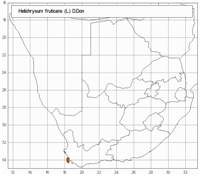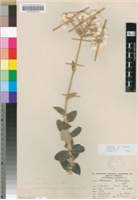Origin of name:
fruticans = shrubby
Diagnostic characters:
Large, bi-coloured leaves covered by hairsLarge heads in open branched inflorescenceWhite bracts
Description:
Stem robust, c. 1 m tall, nude below, densely leafy above, simple or subsimple, flowering stem white-woolly, closely leafy becoming pedunculoid below the heads. Leaves up to 60 (�100) x 30 mm, diminishing in size upwards and becoming distant, elliptic to oblong-elliptic, apex obtuse to subacute, mucronate, base broad, half-clasping, upper surface thinly white-woolly, lower densely so, 3-nerved. Heads homogamous or occasionally heterogamous, campanulate, c. 11 x 20 mm across the radiating bracts, many in a compact corymbose panicle up to 110 mm across. Involucral bracts in c. 10 series, graded, loosely imbricate, inner much exceeding flowers, radiating, acute to subobtuse, dull, snow-white. Receptacle nearly smooth. Flowers 50�78, occasionally 1 female. Achenes 1.5 mm long, barrel-shaped, ribbed, with duplex hairs, not myxogenic. Pappus bristles many, tips subplumose, bases cohering strongly by patent cilia.
Flowering between September and December.
Distribution:
Mountain slopes. Endemic to the mountains of the Cape Peninsula.
Fynbos Biome.
Notes:
Close to H. grandiflorum but distinguished by its larger heads (involucre c. 11 mm long, not 7 mm, with involucral bracts much exceeding the flowers) arranged in a spreading corymb, not in a tight cluster.
Taxonomy:
Literature:
Helichrysum fruticans (L.) D. Don in Sweet, Hort. Brit. 222 (1826); Less., Syn. Comp. 288 (1832); DC., Prodr. 6: 175 (1838); Harv. in F.C. 3: 225 (1865); Moeser in Bot. Jb. 44: 310 (1910); Levyns in Adamson & Salter, Fl. Cape Penins. 782 (1950).
Type:
Cape of Good Hope (LINN 989.5).
Synonym(s):
Gnaphalium fruticans L, Mant. alt. 282 (1771); J. Sims in Curtis's Bot. Mag. t. 1802 (1816). Astelma fruticans (L.) Ker-Gawl., Bot. Reg. t. 726 (1821).
Vouchers:
Bolus 4502 (BOL); Compton 14025 (NBG; PRE); Galpin 4140 (PRE); Rodin 3219 (BOL).

